Looking for email APIs that make integration easier? Here's a quick rundown of five email APIs with user-friendly documentation that simplifies development:
- Postmark: Offers a clear structure, practical code samples, and detailed error-handling guides.
- SendGrid: Includes multi-language examples, interactive features, and easy-to-follow tutorials.
- Mailgun: Provides organized sections, step-by-step guides, and security-focused resources.
- Resend: Features a unique test mode for safe email simulation and robust testing tools.
- Amazon SES: Seamlessly integrates with AWS, offering practical guides and troubleshooting resources.
Quick Comparison
| Provider | Programming Languages | Key Features |
|---|---|---|
| Postmark | Ruby, .NET, PHP, Node.js, Java | Step-by-step guides, error-handling tips |
| SendGrid | Python, Java, C#, Ruby, PHP, Go | Interactive docs, multi-language support |
| Mailgun | Python, Java, PHP, Go, Node.js | RESTful API, SDKs, security examples |
| Resend | Node.js, Rust, Python, .NET, PHP | Test mode, React Email support |
| Amazon SES | Java, .NET, Python, Ruby, Go | AWS integration, troubleshooting guides |
These APIs stand out for their ease of use, making them ideal for developers working on email solutions.
Emails by API: Part 2 - SendGrid
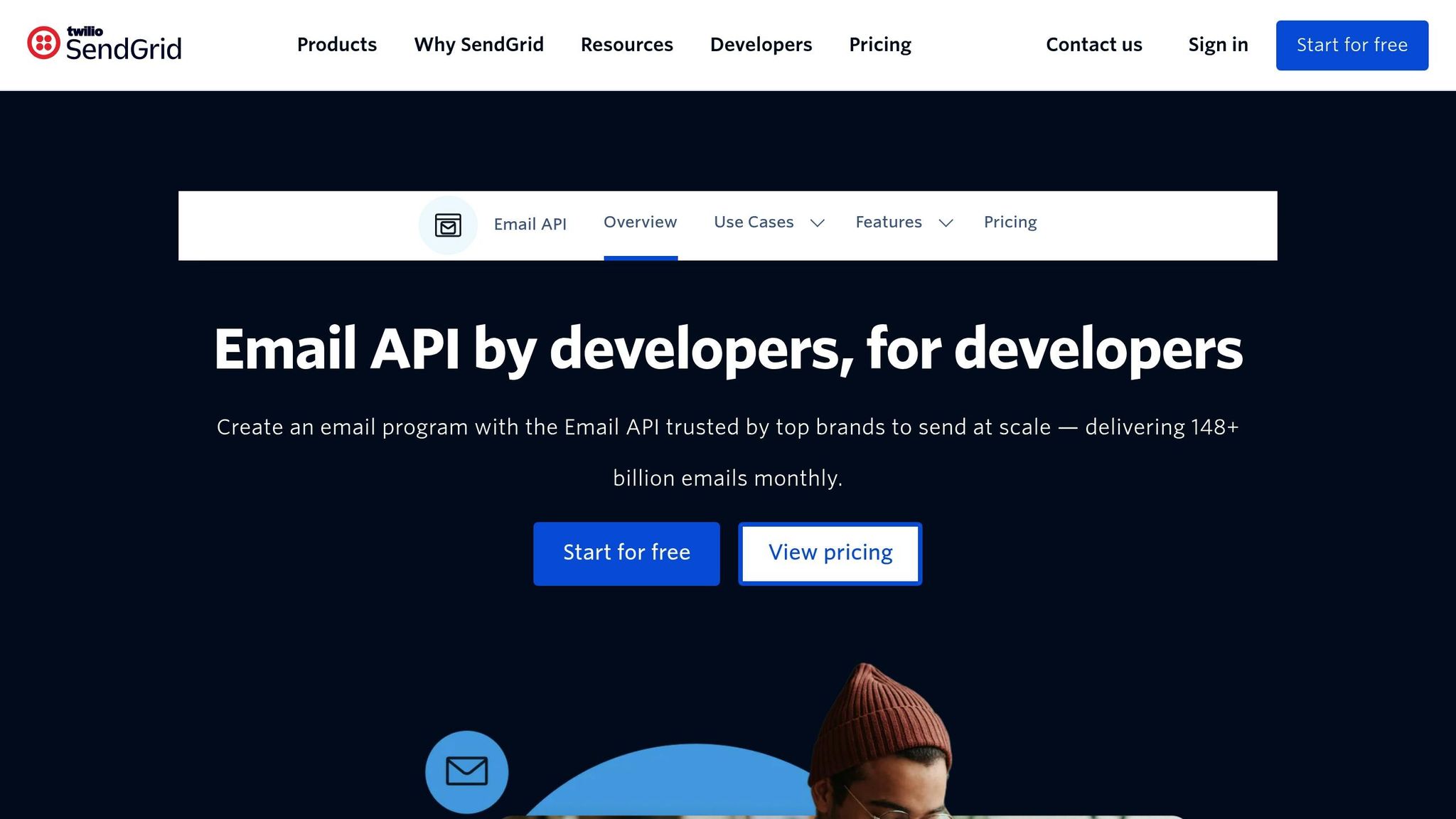
1. Postmark
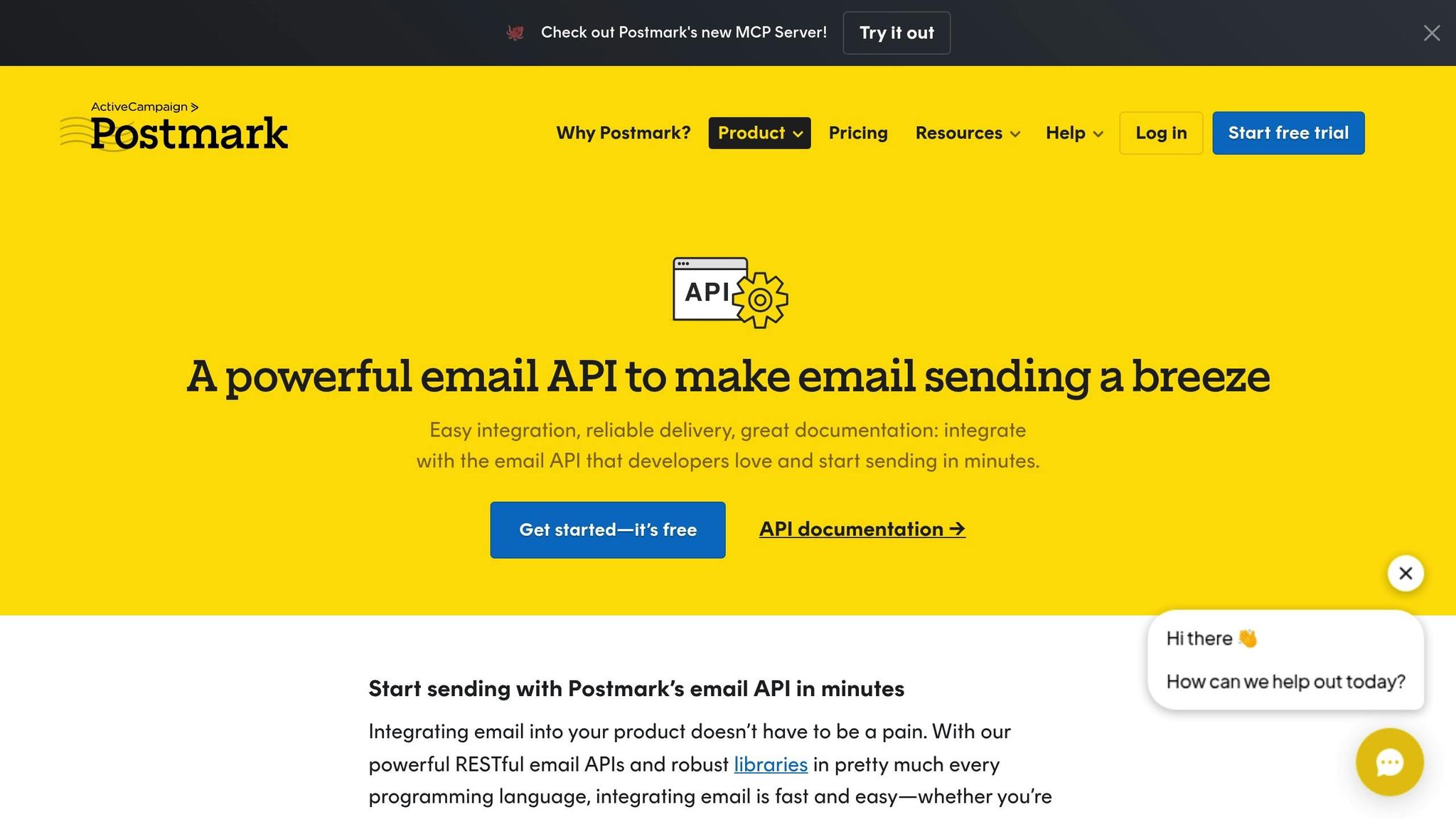
Postmark sets a high standard for API documentation by prioritizing clarity and practicality. With its developer-focused design, the platform shows how well-organized content and actionable examples can make integration smooth and frustration-free.
Clarity and Structure
Postmark’s documentation is thoughtfully structured, guiding developers step by step through the integration process. Its navigation sidebar is neatly divided into five main sections: Overview, Integration, User Guide, API Reference, and Webhooks. Within the API Reference, endpoints are grouped into categories like Email, Bulk, Bounce, and Templates, making it easy to find what you need.
Each endpoint includes essential details like the HTTP method, URL, request headers, and parameters. One standout feature is the "Things you should know" section, which highlights critical information upfront. It covers topics like Message Streams, sender signature requirements, email size limits, and recipient restrictions - helping developers avoid common pitfalls.
Code Samples and Tutorials
Postmark shines with its ready-to-use code examples. Every API endpoint includes curl command samples for single and batch email sending, letting developers test functionality instantly without writing additional code. These examples are practical and designed for immediate use.
The platform also supports multiple programming languages through a mix of official and community-built libraries, all prominently listed in the Integration section. This eliminates the need for developers to work with raw HTTP requests, significantly speeding up the integration process.
In addition to code examples, the User Guide section offers task-specific tutorials like "Sending email with API" and "Processing email". These walkthroughs address real-world scenarios, making them incredibly helpful for developers tackling common tasks. Postmark also goes the extra mile by addressing potential challenges with robust error-handling resources.
Error Handling and Troubleshooting
Postmark doesn’t just provide examples - it ensures developers are equipped to handle errors effectively. The documentation explains common HTTP response codes (like 200, 401, 404, 422, and 500) and what they mean in the context of email sending.
Beyond standard HTTP codes, Postmark includes a detailed list of API-specific error codes. Each entry comes with a unique ErrorCode and a clear, descriptive message. This level of detail allows developers to implement precise error-handling mechanisms and deliver better feedback to their users.
One particularly useful insight is how Postmark handles batch API responses. The documentation warns that batch endpoints return an HTTP 200 status even when individual messages fail. Developers are advised to check the ErrorCode for each message in the response, preventing unnoticed errors that could disrupt email delivery.
2. SendGrid
SendGrid stands out with its well-structured documentation, offering multi-language code samples and straightforward tutorials. This setup helps developers integrate the API smoothly, no matter their preferred technology stack.
Code Samples and Tutorials
SendGrid provides examples for sending emails using its API in eight programming languages: cURL, Python, Node.js, Java, C#, Go, Ruby, and PHP. The "Getting Started with the SendGrid API" tutorial walks developers through the essentials, like setting up prerequisites, making their first API call, and sending an email using cURL. To make things even easier, SendGrid includes Quickstart guides and Code Exchange resources, designed to speed up the development process. These practical examples make the documentation approachable and highly useful.
Interactive Documentation Features
SendGrid's interactive documentation bridges the gap between high-level overviews and detailed technical specs, offering developers a seamless way to dive into the API.
Clarity and Structure
Whether you're a beginner or a seasoned developer, SendGrid's documentation has you covered. Quickstart guides simplify the onboarding process for newcomers, while in-depth API references cater to experienced users. Plus, the code samples maintain a consistent structure across all supported languages, making it easier to compare methods and grasp the core concepts.
3. Mailgun
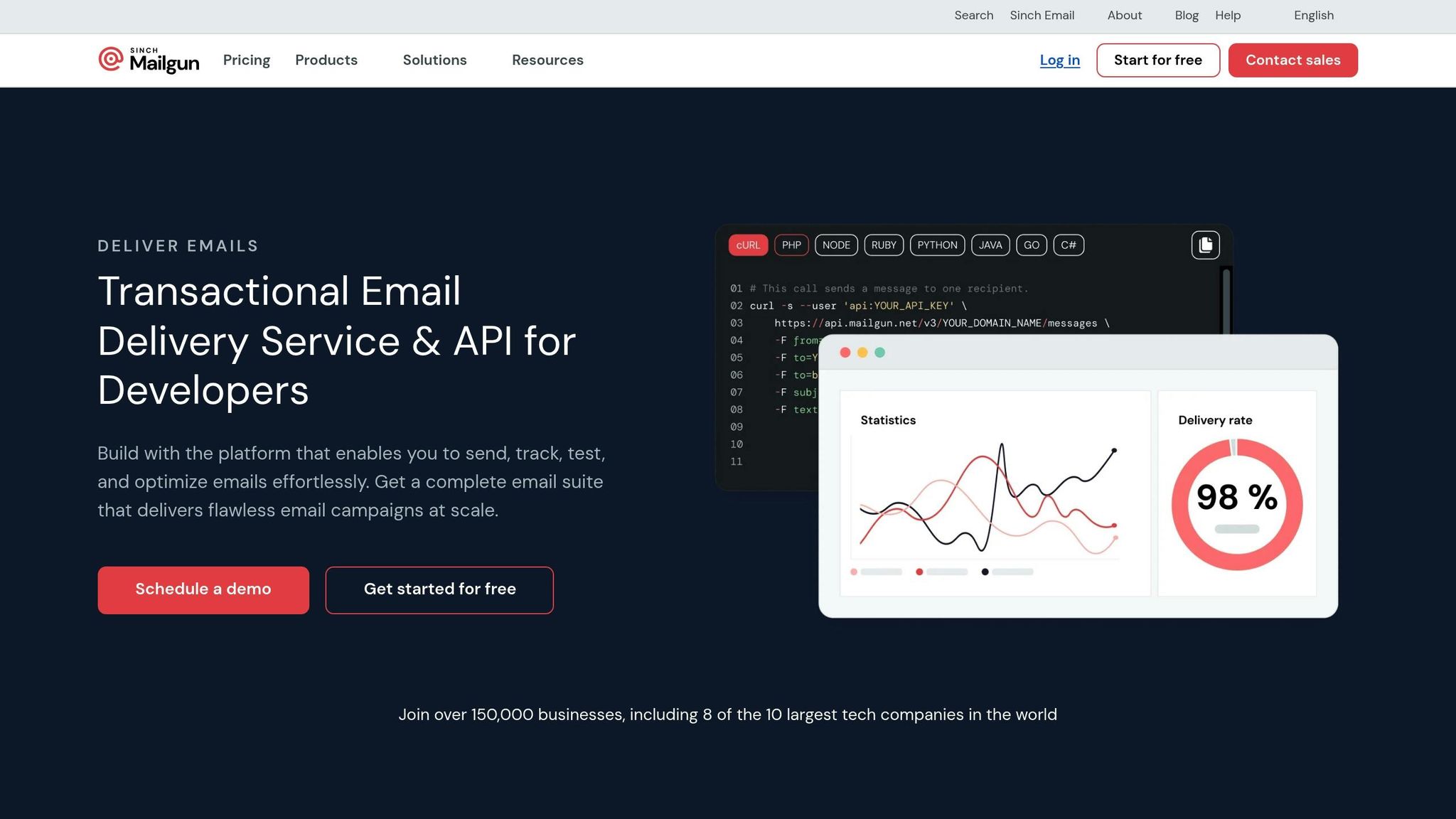
Mailgun offers documentation that's both detailed and practical, making it a valuable resource for developers. Similar to platforms like Postmark and SendGrid, Mailgun combines a well-organized structure with actionable examples to streamline the development process.
Clarity and Structure
The documentation is organized into sections such as "Getting Started", "SDKs", and "API Reference", making it easy to find the information you need. It also includes a full OpenAPI specification and employs a resource-oriented design that aligns with its RESTful API. This means developers can expect predictable URL patterns and standard HTTP responses, simplifying their workflow.
Code Samples and Tutorials
Mailgun stands out with its step-by-step tutorials and practical code examples tailored to real-world use cases. The platform supports multiple programming languages, offering SDKs for Node.js, Go, PHP, Java, and Ruby, each accompanied by clear integration guides.
For instance, the Python tutorial walks developers through project setup, sending basic and batch emails, and handling errors using try-except blocks. Meanwhile, the C# guide explains how to integrate the API using HttpClient and demonstrates handling POST requests with MultipartFormDataContent.
Error Handling and Troubleshooting
Mailgun's documentation doesn't just stop at the basics - it also dives into error handling and troubleshooting. It includes code snippets for addressing common HTTP errors like 400, 401, 429, and 500. Additionally, it provides security-focused examples, such as Frontend Only Authorization (FoAz), which demonstrates how to securely use JavaScript with fetch for POST requests without exposing private API keys. These resources are designed to help developers build secure and reliable applications.
sbb-itb-6e7333f
4. Resend
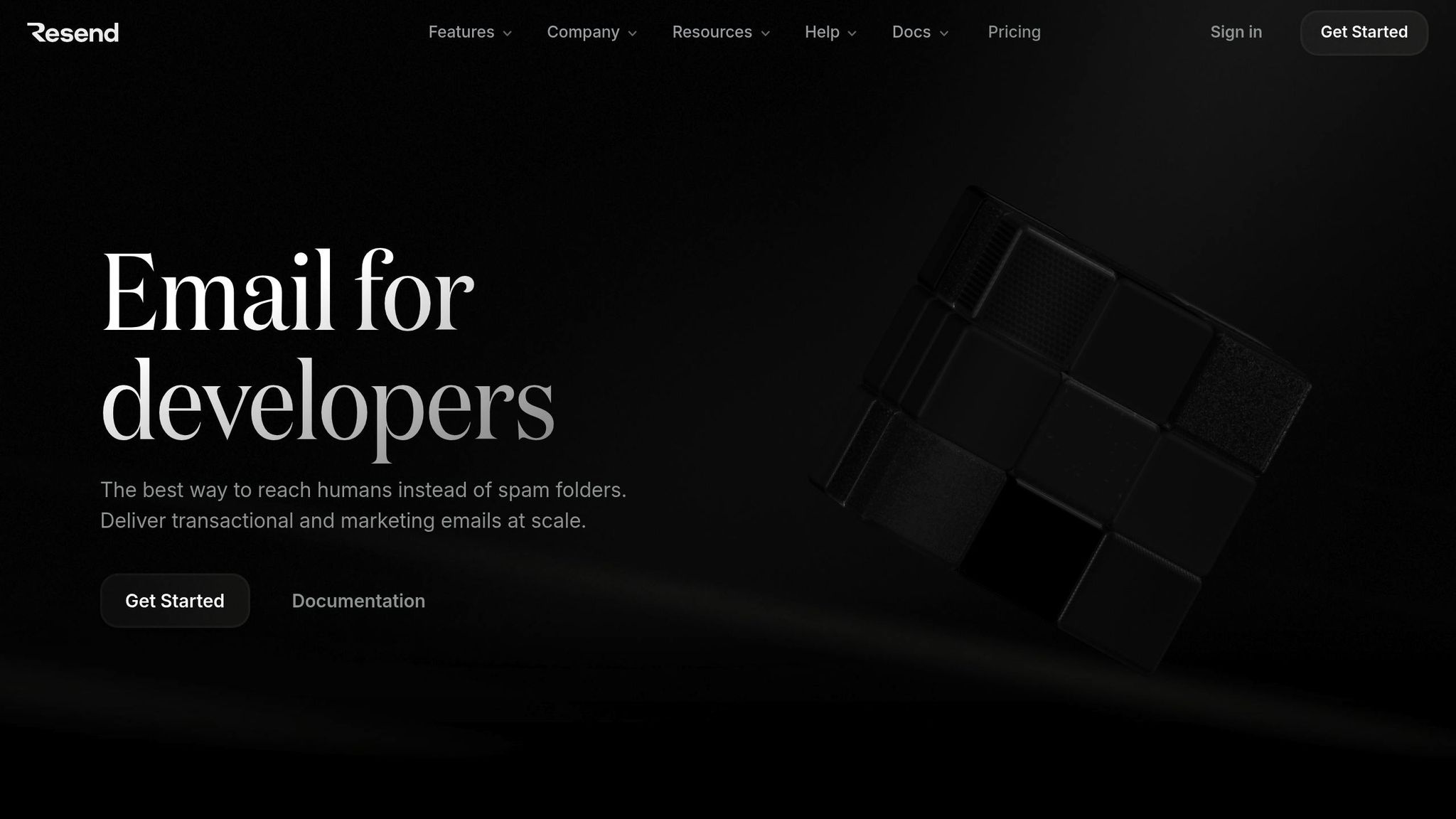
Resend, like other leading email APIs, emphasizes clear documentation and prioritizes developer safety with features like dedicated testing environments. One standout feature is its Test Mode, which allows developers to simulate email events without risk.
Interactive Documentation Features
Resend's Test Mode is a game-changer for developers, enabling them to safely simulate email events - a critical need during API development. The platform provides specific test email addresses to replicate various scenarios:
delivered@resend.dev: Mimics successful email delivery.bounced@resend.dev: Simulates email rejections.complained@resend.dev: Tests spam complaint handling.
These test addresses integrate seamlessly with Resend's Dashboard, Webhooks, and API, making the testing process smooth and efficient. Developers can also use labeled variations (e.g., delivered+user1@resend.dev) to distinguish between multiple scenarios. This setup ensures that testing tools are not only accessible but also highly adaptable to different needs.
Error Handling and Troubleshooting
To further safeguard sender reputation, Resend prevents email sends to domains like @example.com or @test.com. Instead, developers are directed to use the platform's safe test addresses for troubleshooting and testing. This proactive approach minimizes errors and builds trust in the system.
5. Amazon SES
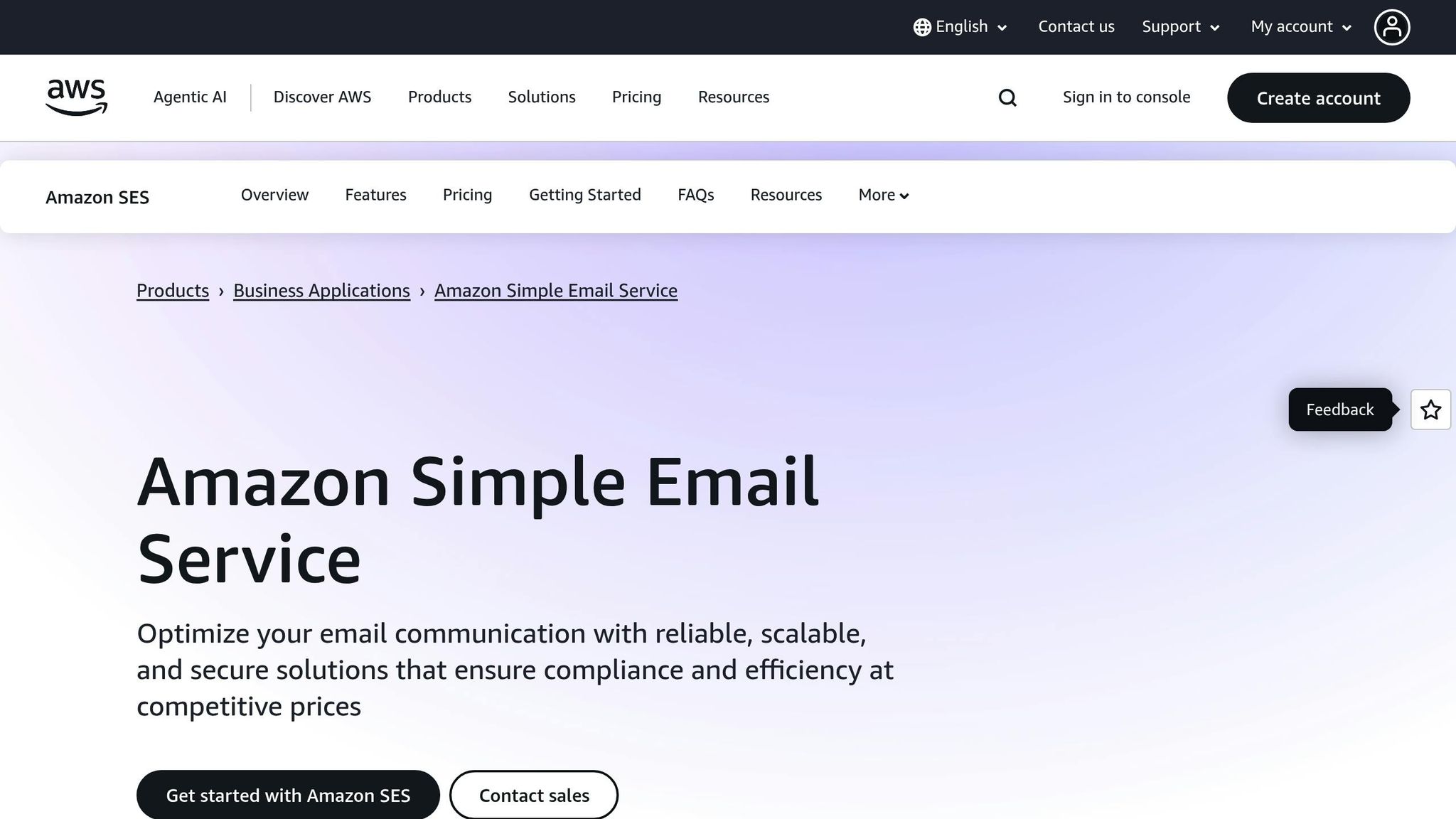
Amazon Simple Email Service (SES) offers a scalable way to send emails, fitting seamlessly into the AWS ecosystem. It caters to both beginners and experienced developers.
Clear Documentation and Structure
Amazon SES documentation is well-organized, breaking down the process into manageable sections. From setting up an account to verifying your domain, the Getting Started guide walks users through the basics with straightforward language. Beyond the essentials, the documentation includes practical guides to help users tackle more advanced tasks.
Code Examples and Tutorials
For developers, Amazon SES provides plenty of hands-on resources. There are code samples and tutorials for tasks like creating email templates and managing bounce handling. These examples make it easier to implement features quickly and customize them to specific needs.
Error Handling and Troubleshooting
Amazon SES documentation doesn’t leave users in the dark when issues arise. It includes detailed explanations of error responses and step-by-step troubleshooting guides. This makes integration smoother and helps resolve problems efficiently.
Documentation Features Comparison
Having quality documentation is essential for smooth email API integration. Each provider approaches developer support differently, and understanding these variations can help you choose the best option for your project.
| Provider | Programming Language Support | Code Samples | Key Features |
|---|---|---|---|
| Postmark | Ruby, Ruby on Rails, .NET, Java, PHP, Node.js | Comprehensive code snippets | Detailed logs for transactional emails |
| SendGrid | C#, Go, Java, Node.js, PHP, Python, Ruby | Extensive code examples | Strong CRM support and full-stack integration |
| Mailgun | Python, Go, Node.js, PHP, Java, Ruby | Effective code examples | Quick integration for transactional and marketing emails |
| Resend | Node.js, PHP, Laravel, Python, Ruby, Go, Java, Rust, .NET | Rich examples including React Email | Modern developer experience with React Email integration |
| Amazon SES | Java, .NET, PHP, Python, Ruby, Go | Practical tutorials and samples | Deep AWS ecosystem integration and scalability |
Each provider customizes its documentation to cater to different development environments, making it easier for developers to implement email solutions.
Key Takeaways on Language Support
- Postmark focuses on widely-used frameworks like Ruby on Rails and .NET, making it a strong choice for traditional web applications.
- SendGrid offers diverse enterprise language support, making it well-suited for integrating with CRM and ERP systems.
- Resend includes cutting-edge languages like Rust alongside established ones like Java and .NET. Its support for React Email integration appeals to developers creating modern CRM and ERP solutions.
- Mailgun provides SDKs for both transactional and marketing email use cases, offering flexibility for various application needs.
- Amazon SES leverages AWS SDKs for email functionality, enabling seamless automation for users deeply embedded in the AWS ecosystem.
For developers working on enterprise-level systems, having broad programming language support and clear, well-structured documentation can significantly reduce development time and simplify integration. These differences in resources and language options are critical when connecting email APIs to CRM and ERP platforms.
Conclusion
Great API documentation isn't just a nice-to-have - it’s a game-changer for speeding up development and ensuring project success. The five providers we’ve covered - Postmark, SendGrid, Mailgun, Resend, and Amazon SES - show how top-notch documentation can make all the difference in creating a smooth integration process and keeping developers happy.
As we’ve seen, poor or incomplete documentation can quickly lead to headaches, delays, and frustrated developers. On the flip side, the best providers treat their documentation as a core part of their service, which directly enhances the Developer Experience (DX). It’s not just about having the right features; it’s about making those features easy to understand and implement.
When choosing an email API for your business, focus on providers that prioritize user-friendly documentation. Look for guides and resources that are clear, well-organized, and approachable for both technical and non-technical team members. Overly complex or disorganized documentation can slow down your team and make integration far more difficult than it needs to be.
Good documentation doesn’t just save time - it simplifies integration with tools like CRM and ERP systems, helping your team hit the ground running. For a curated list of top email API options, check out the Email Service Business Directory. It’s a great resource to compare solutions and find the right fit for managing transactional emails, customer campaigns, or enterprise-level needs.
FAQs
What should I consider when choosing the best email API for my project?
When choosing the best email API for your project, prioritize ease of integration, scalability, and pricing. APIs with clear and well-structured documentation can make implementation smoother, which is especially helpful if you're working under tight deadlines.
Think about your specific requirements, like email tracking, security features, or customer support. For instance, some APIs are more tailored to handle transactional emails, while others shine when it comes to analytics and advanced tracking capabilities. Checking user reviews and case studies can give you a better sense of how an API performs in practical, day-to-day use.
The goal is to select an email API that aligns with your project’s needs while offering a solid mix of reliability, useful features, and affordability.
Why is using email APIs with excellent documentation important for developers?
Email APIs that come with clear and detailed documentation are a game-changer for developers. They provide straightforward instructions, practical code examples, and compatibility with multiple programming languages. This means less time spent figuring things out and more time dedicated to building and improving applications.
Good documentation doesn't just save time - it also reduces errors and ensures a smoother integration process. Developers can count on these APIs for reliable performance, which boosts productivity and leads to better project results.
What are the key differences in the integration process for the top email APIs featured in the article?
The way you integrate an email API can vary depending on how complex its setup is and the tools it offers. Some APIs are designed to keep things simple, featuring user-friendly RESTful interfaces. These let you get started quickly with just an API key and basic HTTP requests. On the other hand, some APIs come with more advanced options, like SDKs and detailed configuration tools, which might involve additional steps such as installation and setting up the right environment.
The key differences boil down to ease of use, flexibility, and customization options. Some APIs are great for developers who need to get things up and running quickly, while others cater to those who require more advanced features. Ultimately, the right choice will depend on your project's specific technical needs and overall goals.


